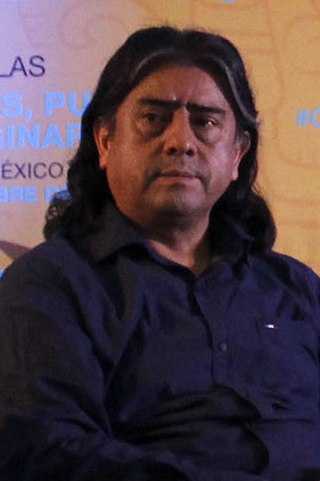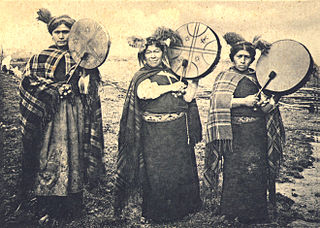In Tahiti and adjacent islands, the term Maohi refers to the ancestors of the Polynesian peoples.

The Chittagong Hill Tracts, often shortened to simply the Hill Tracts and abbreviated to CHT, are group of districts within the Chittagong Division in southeastern Bangladesh, bordering India and Myanmar (Burma). Covering 13,295 square kilometres (5,133 sq mi), they formed a single district until 1984, when they were divided into three districts: Khagrachari District, Rangamati Hill District, and Bandarban District.

Mapuche ; from mapu 'land' and dungun 'speak, speech') is an Araucanian language related to Huilliche spoken in south-central Chile and west-central Argentina by the Mapuche people. It is also spelled Mapuzugun and Mapudungu. It was formerly known as Araucanian, the name given to the Mapuche by the Spaniards; the Mapuche avoid it as a remnant of Spanish colonialism.

The Mapuche is a group of native indigenous inhabitants of south-central Chile and southwestern Argentina, including parts of Patagonia. The collective term refers to a wide-ranging ethnicity composed of various groups who share a common social, religious, and economic structure, as well as a common linguistic heritage as Mapudungun speakers. Their homelands once extended from Choapa Valley to the Chiloé Archipelago and later spread eastward to Puelmapu, a land comprising part of the Argentine pampa and Patagonia. Today the collective group makes up over 80% of the indigenous peoples in Chile and about 9% of the total Chilean population. The Mapuche are concentrated in the Araucanía region. Many have migrated from rural areas to the cities of Santiago and Buenos Aires for economic opportunities.

Aucán Huilcamán Paillama is the leader ("werkén") of the indigenous Mapuche organization Consejo de Todas las Tierras. He intended to run for president in the 2005 election, but his candidacy was not accepted as he was not able to collect enough official votes validated by public notaries.
The locality of Shamatak Grande is in the El Cenepa District in the department of Amazonas, Peru.

The religion of the indigenous Mapuche people of south-central Chile and southwestern Argentina is an extensive and ancient belief system. Legends and myths are common to the various groups that make up the Mapuche people. These myths tell of the creation of the world and the various deities and spirits that reside in it.

Inti is the ancient Inca sun god. He is revered as the national patron of the Inca state. Although most consider Inti the sun god, he is more appropriately viewed as a cluster of solar aspects, since the Inca divided his identity according to the stages of the sun. Worshiped as a patron deity of the Inca Empire, Pachacuti is often linked to the origin and expansion of the Inca Sun Cult. The most common belief was that Inti was born of Viracocha, who had many titles, chief among them being the God of Creation.
The Chilote mythology or Chilota mythology is formed by the myths, legends and beliefs of the people who live in the Chiloé Archipelago, in the south of Chile. This mythology reflects the importance of the sea in the life of Chilotes.
The legend of Trentren Vilu and Caicai Vilu (Kaikai) is a Mapuche flood myth that tells the story of a fierce battle between two mythical snakes, Trentren Vilu and Caicai Vilu. It explains how the Chilóe archipelago and mountains of southern Chile came to have its unique geography.
In Mapuche mythology, Ngen or " Ngen-ko " are spirits of nature of the Mapuche beliefs. In Mapudungun, the word ngen means "owner".
The wekufe, also known as huecufe, wekufü, watuku, huecufu, huecubo, huecubu, huecuvu, huecuve, huecovoe, giiecubu, güecubo, güecugu, uecuvu, güecufu; is an important type of harmful spirit or demon in Mapuche mythology. The word wekufe comes from the Mapudungun word wekufü meaning "demon, outside being".
The Aweer are a Cushitic ethnic group inhabiting the Coast Province in southeastern Kenya. Some members are also found in southern Somalia. They are indigenous foragers, traditionally subsisting on hunting, gathering, and collecting honey.
Chaotroquin or Chaotrokin, is the most important god in Huilliche religion; he belongs to the Mapuche culture and is equivalent to the god Ngenechen of the Mapuche religion.

Tesker or Tasker is a village and rural commune in Niger. As of 2010, it had a population of 33,544 people. It is the birthplace of musician Mamane Barka . The sparsely populated commune extends over a wide area and spans two major regions: the Sahel region in the south and the Sahara desert in the north. In the northeast, it rises up to a height of 710 metres (2,330 ft) at the Termit Massif. It is bordered by Fachi and Tabelot in the north, N'Gourti to the east, Alakoss, Kellé and N'Guelbély to the south and Tenhya to the west. The municipality is divided into 36 administrative villages, one traditional village, three hamlets, 29 camps and 144 watering places.

Philippe Paul Alexandre Henri Boiry was a journalist and a pretender to the throne of the Kingdom of Araucanía and Patagonia from October 26, 1952 to January 5, 2014.
The Bakoya are pygmies, earlier known as Négrilles or Babinga, who inhabitant the rainforest between Cameroon and the Great Lake region of the Congo Basin in Central Africa. Since the 1930s, the Bakoya, in particular, have settled in Gabon in the Ogooue-Ivindo Province, in the northeastern region of the country. Similar minority groups are the Babongo and the Baka pygmies. Before they adapted to the agricultural practices in the new settlements in Gabon along the flanks of the road, Bakoya were “semi-nomadic hunter-gatherers” like the other forest-dwelling pygmies; they resided in small huts. The word 'Pygmee' is a French coinage, adopted by the Gabonese. They are the earliest inhabitants of the forest and are nomadic hunter gatherers.
As an archaeological culture, the Mapuche people of southern Chile and Argentina have a long history which dates back to 600–500 BC. The Mapuche society underwent great transformations after Spanish contact in the mid–16th century. These changes included the adoption of Old World crops and animals and the onset of a rich Spanish–Mapuche trade in La Frontera and Valdivia. Despite these contacts Mapuche were never completely subjugated by the Spanish Empire. Between the 18th and 19th century Mapuche culture and people spread eastwards into the Pampas and the Patagonian plains. This vast new territory allowed Mapuche groups to control a substantial part of the salt and cattle trade in the Southern Cone.
Mama Quilla, in Inca mythology and religion, was the third power and goddess of the moon. She was the older sister and wife of Inti, daughter of Viracocha and mother of Manco Cápac and Mama Uqllu (Mama Ocllo), mythical founders of the Inca empire and culture. She was the goddess of marriage and the menstrual cycle, and considered a defender of women. She was also important for the Inca calendar.
Punto Final was a biweekly news and political magazine published in Santiago, Chile. The magazine was in circulation between September 1965 and 9 March 2018.







